Saddle Fitting Guide for English Style Saddles
Saddle Fitting Guide by Maureen Webb (HP Saddle Fitter)
When you mention 'Saddle Fitting' to many people (and some saddle fitters!), they only consider ONE thing - The angle of the tree at the front of the saddle, which usually come in various sizes - Narrow, Medium, wide, extra-wide, etc. This is the ONLY one of the fourteen essential aspects to correct saddle fit, that Adjustable Gullet Saddles (which is a misnomer, as none of them can adjust the gullet width at all!) address.
People also wrongly assume that if you can get 3 fingers wither clearance, with the rider on board, then the saddle fits at the withers. This is NOT true, though it is an important point out of the 14 points.
The 14 essential point for correct saddle fit are these::
Saddle Tree Angle
The tree angle must be the same as the angle of the horse's shoulder at a point 2 to 3 inches behind the rear edge of the shoulder blade. This is determined by doing a wither tracing at this point and matching it to the angle of the tree of the saddle. The saddle must then be checked, with a rider on board and a second person runs their flat hand from top to bottom of the front of the tree, under the front panels. There should be an equal, even pressure all the way down - not tighter at the top than the bottom, or vice versa.
The above is the only point that adjustable gullet saddles allow you to change.
Saddle Tree Width
This is one of the points of saddle fit that I see incorrectly fitted very often The Tree Width is the width of the tree at the front of the saddle, between the panels. It has nothing to do with tree angle. It is possible to have a horse that needs a wide tree width, but a narrow tree angle at the same time. Look at the 3 saddles in the photo. They are all sold as 'Wide', as the tree angles are the same, but the bottom one has almost double the tree width between the top of the panels. This tree width is important, as the horse must be able to rotate the shoulder backwards without the tree being in the way. On a wide shouldered horse, the 'Wide' saddle in the centre would prevent all rotation. The shoulder blade would hit the front of the tree and the points and the horse would soon start evasions such as being reluctant to do sharp turns, resistance going into trot and canter, 'Pig-rooting', etc.
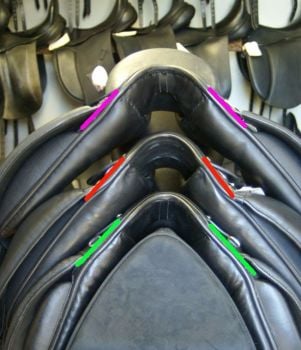
Photo with kind permission of Kitt Hazelton, Panther Run Saddlery
Saddles that are too narrow in tree width also cause hollows to develop behind the horse's shoulder. These hollows are caused by the death of the muscle fibres due to pressure and constant trapping between the shoulder blade and the tree. See photo. This is NOT normal and would never be seen on an unbroken horse. If your horse is developing these hollows, get a different saddle - QUICKLY. This muscle damage is often permanent.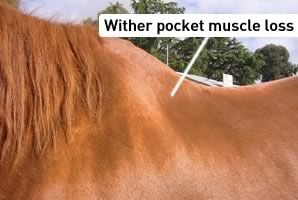
Wither Clearance
Most people know that a saddle must have 2 to 3 fingers wither clearance at the top of the withers, with the rider on board, but did you know that it also has to have at least 2 fingers distance all around the withers, at the sides as well? See the photo. 
When the horse moves, his shoulder blades rotate upwards and backwards. The saddle must have an opening (clearance) on the sides of the panels to accommodate the shoulder rotation, allowing the rear of the shoulder blade to slide, easily, under the front of the panel.
White hairs in this area indicate that the saddle is pinching.
Gullet Channel Width
The gullet must be wide enough not to interfere with the spinal processes or musculature of the horse's back (3-5 fingers), ALL THE WAY from front to back. Too often we see saddles that have a gullet that starts off wide at the pommel and narrows as it goes towards the cantle. This makes NO sense, as the horse's spine does NOT get narrower. The saddle then 'SITS' on the spinal processes at the rear. Buy a saddle like the one on the right of the photo, NOT like the one on the left! The one on the left also has a TWISTED TREE - midway, if you look.
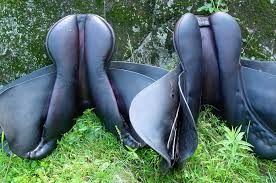
Full Panel Contact
The panel should be in full contact with the horse's back evenly all the way from front to back. This is determined by the shape of the tree from front to back. Saddle trees vary from Flat, (which suits a lot of cob types) to Banana shaped trees (older and sway backed horses) and it is vital that you choose the right shape for your horse, or the weight will not be carried evenly on his back.
To test this, saddle up with the girth done up and run your hand from front to back under each side of the panels.There should be even pressure all the way along, not less in the middle, more in the middle, etc. See photo.
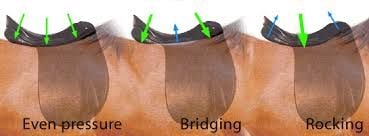
Saddle Length
The rear of the panels should never sit behind the last rib of the horse when the saddle is in the correct position. To find this point, find where his hairlines come together in the area of his flank and draw a line straight up to his spine. The loins must NEVER carry any weight as they are the weakest part of the back. See photo. 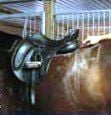
Saddle Straightness
Horses are usually NOT symmetrical. Most horses have one shoulder that is bigger than the other, just as we are right or left handed. This is important as the back of the saddle will always be pushed by the larger shoulder to the side of the smaller shoulder and no matter how you ride, there is nothing you can do about it - unless you have the saddle re-flocked to fit that horse.
Sometimes, a saddle that is straight when standing, is NOT straight after it has been ridden in for a few minutes. This can be due to the rider, but is often due to the uneven shoulders. Such saddles must be re-flocked to take account of the larger shoulder, so that they ride 'STRAIGHT'. See photo 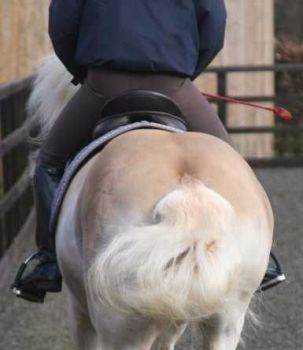
Always check that the problem is not due to a twisted tree first though.
Girthing Point Alignment
The girth straps, when the saddle is positioned correctly on the horse, should hang perpendicular to the ground when they are positioned to be in the girth groove of the horse. They must NOT be at an angle either forwards or backwards when the girth is done up.
So many people have problems with saddles that constantly move forwards or backwards and many times this is due to the girth straps being positioned either too far backwards or forwards on the saddle for that particular horse's girth groove.
Roly-Poly horses almost always have a forward girth groove - this is, the flat part of the chest just behind the front legs before the round of the belly starts. See photo. 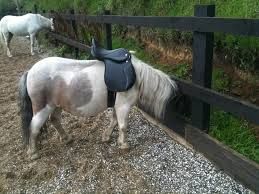
This pony has a very short, forward girth groove. The saddle will ALWAYS move to the position where the girth hangs vertically and in this case, with this saddle, where the girthing points are too far back, the saddle ends up on his shoulders!! For this pony, the girth straps would need to be attached to the saddle MUCH further forwards, to stop this happening.
Many Adjustable 'Gullet' Saddles have the Girthing Points too far back for many horses.
Now the points for the rider
Saddle Seat Size
The seat must be the correct size for the rider.
The size of the seat must to be selected based on the weight and body of the rider, and to the saddle model as well. Normally, in flatter seat saddles, the seat size could be smaller than in a deep seat one for the same rider. The rider should be able to place 3 fingers between their bum and the rear of the cantle, when sitting in his correct seat size saddle. The rider must also feel that they are sitting 'IN' the saddle, not perched 'ON' it and this aspect is very rider-shape dependent and only trying the saddle can decide if the saddle seat 'FITS' the rider.
Saddle Skirt Length
The saddle skirt size will depend on rider thigh length.The top of the riding boot should sit at least 5cm above the saddle skirt, to prevent the top of the boot becoming trapped by the bottom of the skirt leather. The skirt must also not be so long as to interfere with the rider's subtle leg aids.
Saddle Balance
The centre of the saddle (seat area where your seat bones sit) should be parallel to the ground while on the horse's back. See photo 7. If the saddle is higher at the front than the back, then you will feel unstable and tipped backwards. If it is higher at the back, then you are tipped forwards and can never achieve balance. 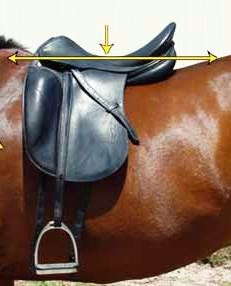
To test this, take a piece of chalk or a short pencil, hold it at the front of the saddle seat and let it go. It will roll to the lowest part of the saddle and this must be in the CENTRE of the seat.
This saddle below is totally wrong for the rider. The Balance is tipped to the front, which forces the rider sit to the back of the saddle, with an arched back. Her back will ache in a very short time riding.
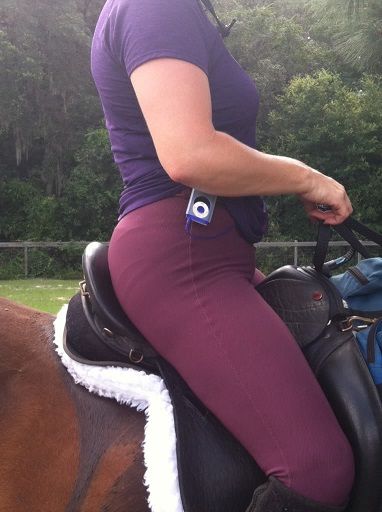
Seat 'Twist' and Seat Width
The Twist of the saddle is the part of the seat that is the narrowest.
Women often have problems with saddles rubbing and putting pressure on the 'bits' that are unmentionable. This prevents the rider for sitting deep and in comfort as the rider is constantly moving forwards and backwards to gain relief, as the discomfort becomes more intense. I know, as I have this problem with a great many saddles!!!
The problem is that most saddles are designed by men. Men have a distance between their seatbones of about 4", but women can vary from 4" to 8" and the wider apart your seatbones, the worse the problem becomes if the 'Twist' is too narrow or high. The pubic bone is also much lower in women than in men. This causes pressure on the soft female bits if the twist is too high or too hard.
The seatbones are meant to sit on the seat of the saddle and with many saddles that I sit on, (my seatbones are 6.5" apart) that part of the seat is too narrow. My seatbones miss the seat altogether and are sitting on the 'ridge', or, with some saddles, past the seat itself!! This then lowers the sensitive bits down onto the saddle, as the saddle seat falls away the lower down you go. Your 'Bits' are then crunched against the narrow or high twist and it is hell after 20 minutes or so.
You must always choose a saddle that fits your own conformation in this area. I myself need a saddle with a wider twist, a shallow rise towards the pommel and a wider seat, or I can't ride in it for very long! The saddle in the next photo would kill me!! It is very narrow where my seatbones sit – my seatbones would be wider than the seat in this area. The narrow, high upward curve of the twist would ‘Mush’ my bits. 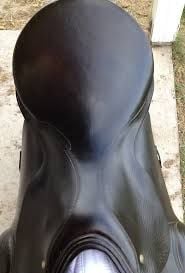
I could ride in this one though.
Stirrup Bar Placement Point
This is very important and the main reason why some riders really struggle to attain the longed for ‘Shoulder/Hip/Heel position and a quiet lower leg. The fact is, on many saddles, they CAN’T.
The stirrup leather with stirrups, will always want to hang vertically. It is a Law of Gravity, particularly when you rise to the trot and your weight is going into the stirrup.
On most GP saddles – and some dressage saddles - the stirrup bar is positioned TOO FAR FORWARD and the rider is forced into a ‘Chair’ seat as a result. In order to have a Shoulder/Hip/Heel position with these saddles, the rider would have to bring the lower leg back – but then the stirrup no longer hangs vertically, but slopes backwards as well. Then the rider goes to trot and the weight goes into the stirrup – which swings forwards under gravity so that it hangs vertically, then the rider pulls the leg bag to the correct position and it swings forwards again with the next rise. Meanwhile, the Instructor is shouting “Keep your lower leg still”, but the rider cannot as it is impossible due to the stirrup bar position being too far forwards on the saddle.
If you want to do dressage at any level, make sure that the saddle you choose has the stirrup bar position far enough back for you to have a vertical stirrup leather when you are in the correct Shoulder/Hip/Heel position. You will then find it easy – a miracle – and your lower leg will be still as well.
The photos below show an enforced Chair Seat with a very expensive saddle. (also note the incorrect saddle position - too far forwards - and calcification of the horse's spinal processes behind the saddle and on the sacroiliac joint! Hind end muscle degeneration too.)
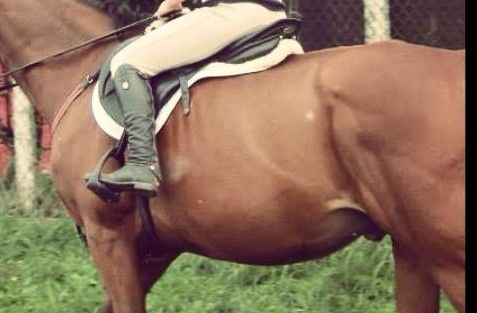
and a Correct Position,easily attained when the stirrup bars are in the correct position – further back on the saddle tree.
Knee and Thigh Block Positions
These must be placed so that the rider's knee and thigh can find the 'Sweet Spot', meant for the leg to rest comfortably, without twisting the ankle or knee outwards, yet still giving support.
If the rider has short thighs, but the saddle has the blocks too low, then this cannot happen. Equally, a long-thighed rider will find that unless the blocks are low enough, her knee will rest on the upper part of the block, above the 'Sweet Spot' and this HURTS!
Many saddles these days have removable blocks with Velcro, to allow the block placement to be adjusted, but this should be done by your saddle fitter, as many riders get the positioning wrong.
Horses did not evolve with Riding as an objective and we must remember this. Humans have decided that riding horses is a good idea – and the unnatural weight that riding places on the horse’s back causes the horse’s conformation - muscle and, in some cases, bone, to change.
Correct saddle fitting is essential for the health of the back, neck, joints, feet and mental health of the horse. The horse's body is Dynamic, changing with every activity and level of fitness and weight gain/loss and the ONLY way to ensure correct saddle fit is to have it checked on a regular basis.
I hope that this has been useful and that it helps you to understand saddle fitting criteria, to choose a good saddle for your horse and yourself and to 'weed out' poorly trained saddle fitters!!
It also shows why 'Adjustable' saddles only address ONE area of saddle fitting – Saddle Tree Angle – the other 13 are left to chance.
Once you have found a saddle that fits both you and your horse, it is VERY important to choose the numnah carefully, as many 'Perfect' saddles are ruined by incorrect saddle pads!!
See this article:
http://dressagefundamentals.com/how-your-half-pad-can-make-or-break-your-ride/
